- Author Matthew Elmers [email protected].
- Public 2023-12-16 21:49.
- Last modified 2025-01-24 09:17.
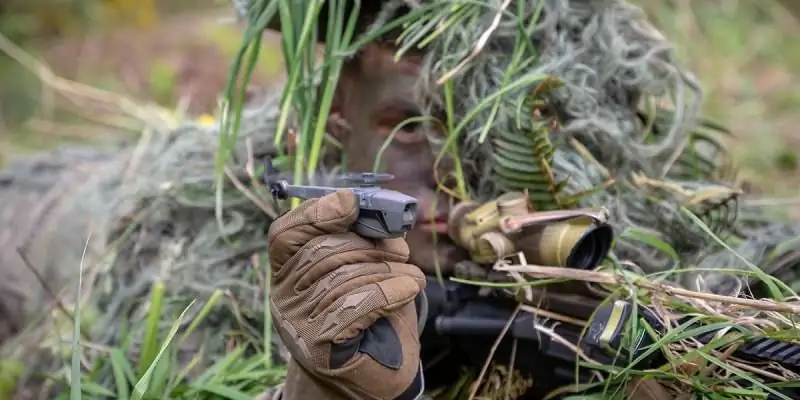
All UAVs considered in this article are included in group 1. This group with a maximum take-off weight of 0 to 9 kg includes a large number of systems of different types, including aircraft and helicopter types, and all of them, as a rule, are launched by hand. Very few of these drones could be categorized as "nano". They are very lightweight systems, mostly with a main rotor, however, like everyone else mentioned in this article. Any soldier dreams of having a flying system at hand that can look "around the corner" and return to perform the following tasks, because its weight and the amount of material and technical maintenance are minimal, that is, a significant increase in its total load is excluded.
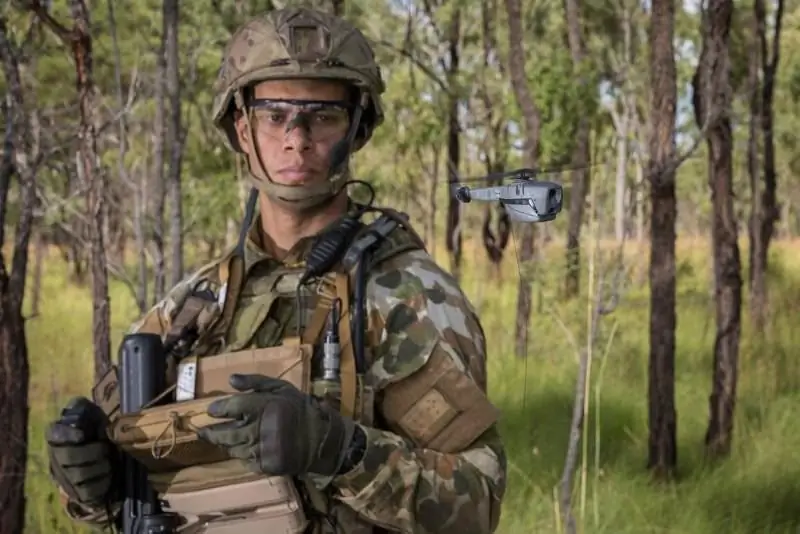
Special forces are usually the first to receive new high-tech systems, which later enter service with conventional units. However, few systems are available for the military in the defense market (of course, all these "leisure" drones sold in hundreds in toy stores are not covered here), only a part of them are first used by special forces and even fewer are those that instantly become bestsellers. Some other, slightly larger drones, which no longer fit into the "nano" category, have rather peculiar characteristics, which makes them an excellent choice for special operations forces (SSO) and beyond.
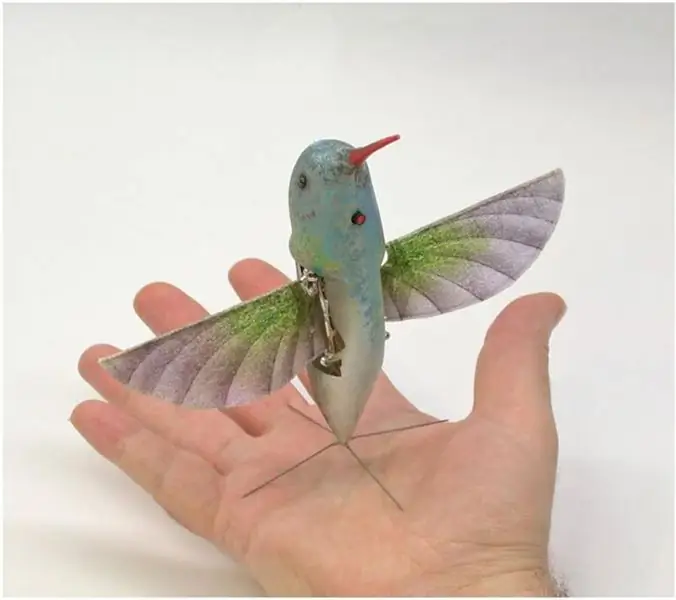
Before we start describing existing systems, let's take a look at what the future may be, although today many things can be attributed to the realm of science fiction rather than reality. In 2011, AeroVironment developed the Nano Hummingbird, a flying bird-like VTOL with a maximum take-off weight of 19 grams, whose wingspan 160 mm allows it to remain airborne. Of course, this is the most complex development in all respects, from mechanics and avionics to the data transmission channel. Charles Stark Draper's Laboratory took a different path, believing that there is no more efficient and maneuverable insect-like nanodron than a drone that mimics a dragonfly. In January 2017, it announced that its DragonflEye program, which is running in partnership with Howard Hughes Medical Institute, has made some progress in dragonfly management thanks to a tiny knapsack that combines navigation, synthetic biology, and neurosensory technologies and sends neurosensory control signals to the dragonfly. Today, the technologies of avian or insect systems are not ready for great commercial success, but the hour will surely come when they will find their grateful user. In the meantime, the current nanodrones mainly use helicopter technologies, which provide the possibility of vertical take-off and landing.

In January 2017, the US Department of Defense issued a request for information called Soldier Borne Sensor Unmanned Aircraft Systems, the purpose of which was to collect information for a future planned program. This time, the goal was to deploy these systems in the regular army to provide surveillance at the level of individual squads and platoons. There were not many systems available on the market that met American requirements, which were announced in January 2018 at a meeting at the so-called Industry Day. Among them: hovering at a low altitude for at least 15 minutes, three flights with a fully charged battery in light wind conditions, the maximum weight of the device is 250 grams, the maximum weight of the entire complex is 1.36 kg. The requirements also provide for the probability of detecting 90% of an object the size of a person from 50 meters in night conditions, plus a maximum training time of 16 hours. The system must store photo and video footage and transmit images to the soldier in real time for immediate use. In addition, selection criteria include visual and acoustic signatures, line-of-sight range and other as-yet-unnamed parameters. Seven companies and organizations showed up for the briefing, but the main competitors quickly dwindled to three participants - AeroVironment, InstantEye Robotics and FLIR Systems.
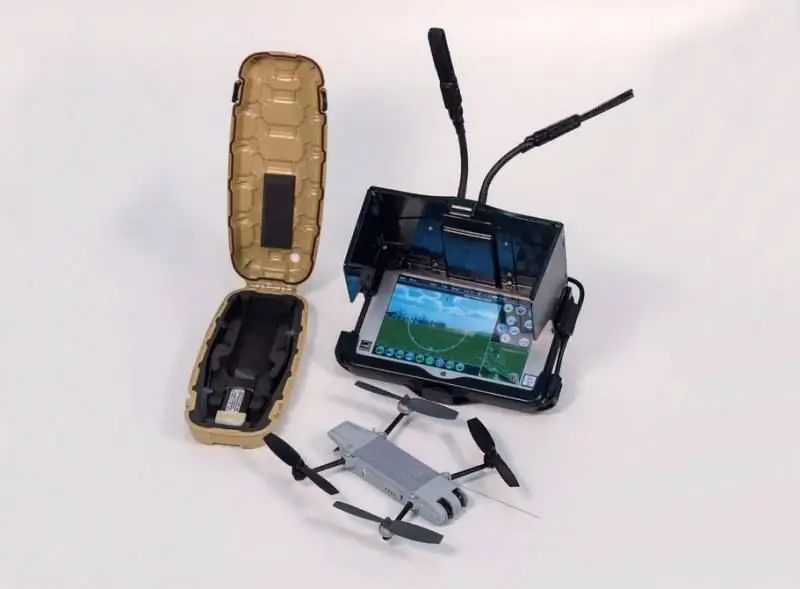
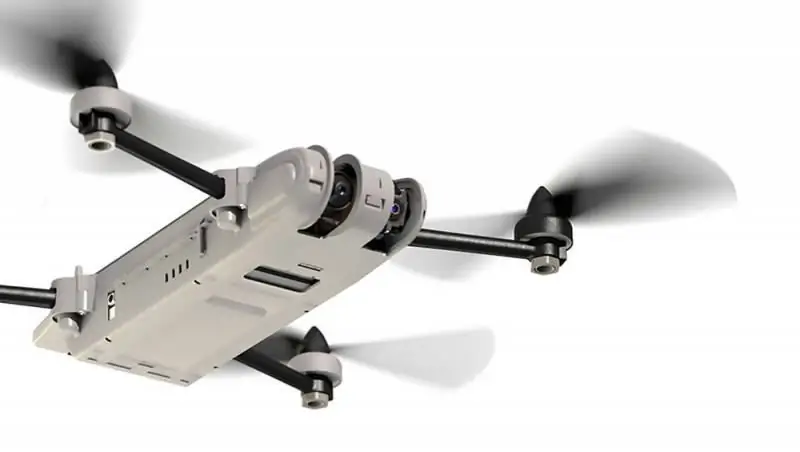
In late November 2016, FLIR Systems acquired the Norwegian company Prox Dynamics AS for $ 134 million in cash. This company is one of the pioneers in the field of nano-UAVs, it was founded at the end of 2007 with the goal of developing the smallest UAVs in the world for professional users. The first version, called the Black Hornet, appeared in 2012, and after a new version appeared, it received the designation Black Hornet 1. “The aircraft was based on a completely new technology, but its flight range was limited to 600 meters, however, as well as the flight duration is 15 minutes,”a FLIR Systems spokesman said. The first customer was the British Army, which, in response to urgent needs, deployed its first PD-100 Black Hornet drones in 2012 in Afghanistan. This became an important fad in the track record of the Norwegian nano-UAV; later in 2015, a second version of the Black Hornet 2 was developed and presented. "It was based on the same platform, but there were many improvements in terms of sensors, range and wind stability." An engine with a lower power consumption was installed on the device, which, in combination with a battery of increased capacity, made it possible to increase the flight range and at the same time increase the range of the data transmission channel. In addition, a variant of the Black Hornet 2T was developed, on which a thermal imager from FLIR was installed, this was the first collaboration between the two companies. The Black Hornet 2 system has been acquired by a number of customers due to its obvious advantages.
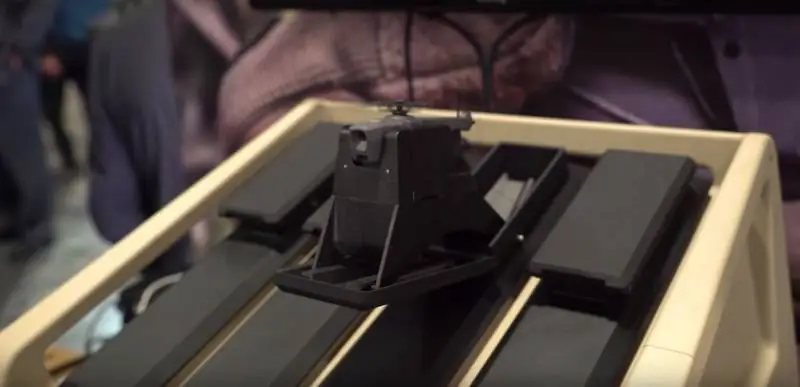
Given the launch of a potentially priority program in the United States, and the fact that the US military is buying at least an order of magnitude more drones than other countries, FLIR decided that it was worth investing more in the field of nanosystems and, in this regard, acquiring Prox Dynamics. After this merger, funding for promising projects increased sharply, resulting in the new Black Hornet 3. Designed by the father of the original Black Hornet, Peter Muren, the device retained the helicopter scheme, but the rotor design was radically revised. The platform is now fully modular, with a removable battery and various target loads allowing for quick reconfiguration of the drone. The new generation base station has received a number of improvements, both hardware and software. The weight of the Black Hornet 3 with a 123 mm propeller has doubled compared to its predecessors and amounted to 33 grams, it can stay in the air for 25 minutes and fly to a maximum distance of 2 km. The drone develops a speed of up to 6 m / s and can fly at wind speeds of up to 15 knots (gusts up to 20 knots), as well as in light rain. In terms of sensors, the drone is equipped with a FLIR Lepton thermal imager and a high-definition video camera capable of taking photographs. A thermal imager with a 160x120 matrix and a pitch of 12 microns operates in the range of 8-14 microns and has a field of view of 57 ° x42 °, its dimensions are 10, 5x12, 7x7, 14 mm, and its weight is only 0.9 grams. Two daytime cameras are available, depending on the configuration, providing respectively video resolution of 680x480 and 1600x1200 still images, there is the possibility of overlaying images from day and night cameras.
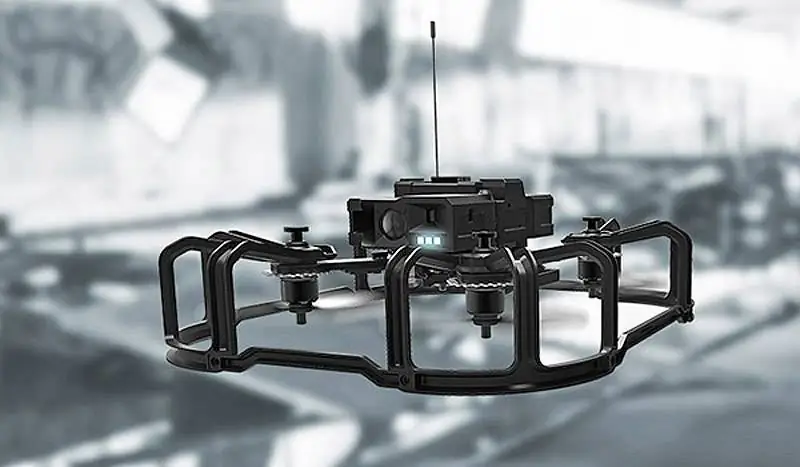
The main innovation in the Black Hornet 3 is that it can fly even without a GPS signal. “However, we continue to develop this feature, as it still has the potential for many improvements,” - said a company representative. Four flight modes are available: automatic and manual hovering and observation, flight along a predetermined route and points selected by the operator, automatic return and loss of communication. “We are constantly updating our software to reduce the cognitive load on the operator. This system, known as the Black Hornet 3 PRS (Personal Reconnaissance System), is integrated with the US Army's ATAK (Android Tactical Assault Kit) software. The complete Black Hornet 3 system weighing less than 1.4 kg includes two aircraft, a hand controller and a video screen. The Black Hornet 3 drone has been purchased by 35 countries, with the largest buyers being the United States, Australia and France. In November 2018, France announced a purchase totaling up to $ 89 million, and a few days later the US signed its first contract for $ 39 million. The UK signed a $ 1.8 million contract in April 2019 as part of the Fast Track Initiative. In the summer of 2019, the US Army received its first Black Hornet 3 PRS systems for the 82nd Airborne Division, which was deployed to Afghanistan. These nanodrones are used for information gathering and reconnaissance at the squad and platoon level.
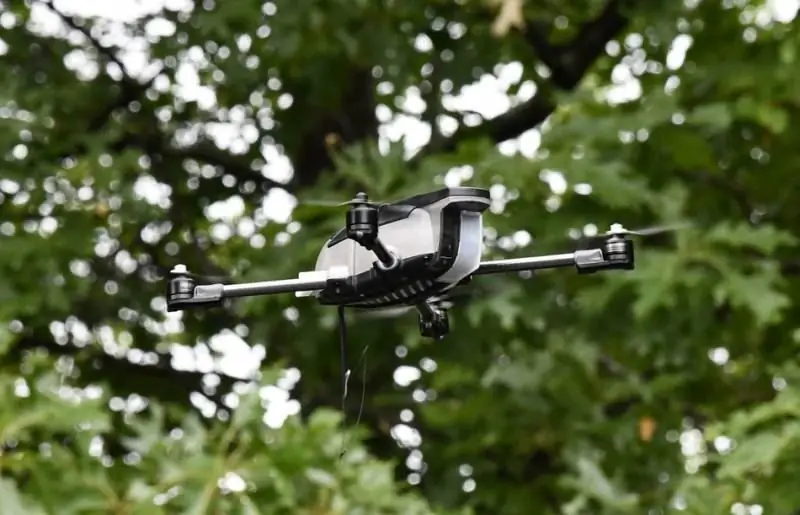
During the development of the PRS drone, FLIR realized that many vehicles needed a short-range reconnaissance system that could be used from under armor. This led to the emergence of the VRS (Vehicle Reconnaissance System), which is based on the same platform and features a launch module with four removable heating and charging cassettes. The VRS kit weighs approximately 23 kg, measures 470x420x260 mm and can optionally be equipped with ballistic protection. It can be easily integrated into the battle management system through a standard interface; Kongsberg has already integrated it into their Integrated Combat Solution (ICS) system. FLIR has demonstrated this system not only as a reconnaissance tool, but also as an aiming tool with integrated GPS. The VRS is currently only available in pre-production, but FLIR is ready to start production as the product was first shown in October 2018 and has been in high demand.

In addition to FLIR, two more contenders fought for the Soldier Borne Sensor contract, AeroVironment and InstantEye Robotics (a division of Physical Sciences Inc). AeroVironment has developed a Snipe quadrocopter weighing 140 grams with a flight duration of 15 minutes and a flight range of more than a kilometer, equipped with optoelectronic and infrared cameras. With a maximum speed of 9.8 m / s, the device is quite silent and inaudible even at a height of 30 meters above the ground, it is controlled by an intuitive application loaded on a touch controller with Windows 7. Preparing the drone for flight, assembled from five moving parts, takes less than a minute. After selecting one of its competitors by the US Army, AeroVironment apparently abandoned the Snipe program.

InstantEye Robotics' Mk-3 GEN5-D1 / D2 quadcopter weighs less than 250 grams (maximum allowed weight). The complex weighing 6, 35 kg includes two devices, one Ground Control Station-D, one protected display, six batteries, a charger, a set of screws, one spare antenna, a transport box and a container for working in the field. The device can reach a maximum speed of 8, 94 m / s and withstand the same wind speed, the range of the data transmission channel is 1.5 meters. The main battery provides a flight time of 12-15 minutes, however, an additional battery guarantees 20-27 minutes of operation. At the end of 2018, InstantEye delivered 32 of these complexes to the US Marine Corps for operational evaluation as part of the small tactical drone program.
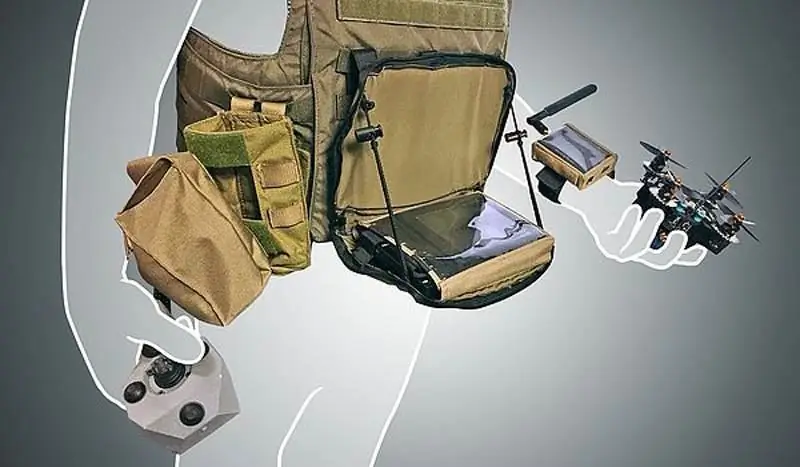
The NanoHawk drone, first shown as a prototype at Eurosatory 2018, was developed by the French company Aeraccess based on the specific needs of the French special forces, which needed a UAV for use inside buildings and other closed structures. In a competition run by the Weapons Control Lab, NanoHawk beat five other candidates in the first round.
In this project, Aeraccess drew on its experience with the larger SparrowHawk drone, developed in conjunction with French police special forces and also capable of operating in the absence of a GPS signal. However, the French special forces wanted to have a significantly smaller system and, as a result, the NanoHawk drone appeared, in which the quadcopter scheme was preserved and light protection of the propellers appeared, which cannot be dispensed with when flying indoors. Compared to the prototype, the serial version is equipped with 360 ° obstacle avoidance sensors. In addition, two optoelectronic / infrared target loads are installed in front and behind, which allows the operator to see the picture from both directions and, thus, better control the situation; optional sensors also enable digital volumetric mapping of buildings. The case, along with the protective structure of the screws, has been completely redesigned, now the user can quickly repair the device in the field. The current version weighs 350 grams without battery, with the maximum takeoff weight increasing to 600 grams with a more powerful battery that provides 10 minutes of flight. The dimensions remain the same, 180x180 mm in screws, however, if the customer requires a new protective cage, the dimensions will increase to 240x240x90 mm.

One of the main elements of the complex is a manual controller, which allows the operator to hold a weapon in the other hand, while the monitor is installed on a bulletproof vest, although it is possible to install it on the back of the shield or put it on the wrist. Intelligent flight modes significantly reduce operator workload, and an orthogonal frequency division multiplexed encrypted data link enables simultaneous flight control and video transmission by using a single cryptographic system with two different frequencies.
Since its first demonstration, the NanoHawk drone has undergone extensive testing. In a typical task, it takes off from the outside of the building, flies into it through an open window, and then moves 3-4 floors down or up depending on the thickness of the walls. The device also received permission to operate on ships, demonstrating its ability to fly above and below the operator without losing radio and video signals, which opens up a completely new market. At night it can be connected to a night vision system so that only the operator can see it. The NanoHawk was also tested with dog crews, during which the dogs were trained to carry the drone by holding it in the mouth with a short leash. The dog begins to check the building and, when he senses the presence of a person in the room, drops the drone outside, after which it takes off on command. The dog can also be equipped with a repeater in order to increase the drone's range, which the developer claims is several hundred meters outdoors.
Each NanoHawk system consists of a data channel, controller, monitor and two devices. The first units to order NanoHawk were the local special operations forces. The French special forces have signed contracts with the company Aeraccess, according to which it received specialized versions of the system. On the export side, Aeraccess has received orders for an unknown number of vehicles from the military and law enforcement agencies of Singapore, the United Arab Emirates, the United Kingdom and Canada.
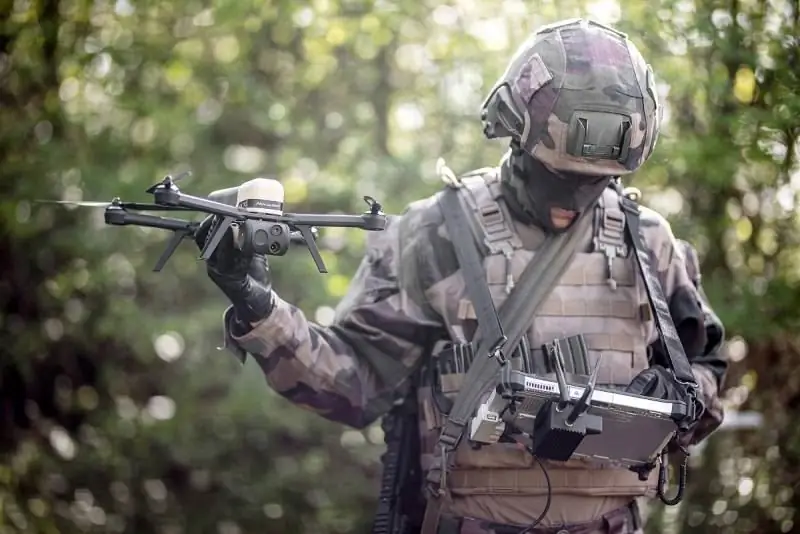
The French army purchased the NX70 microdrones developed by Novadem on an urgent request. This quadcopter with a maximum take-off weight of 1 kg in the unfolded state has dimensions of 130x510x510 mm (when folded - 130x270x190 mm). It is equipped with a dual focal length Ultra-HD day camera providing 50 ° and 5 ° FOVs and a 34 ° FOV; depending on the customer's desire, the matrix of the video converter can have dimensions of 320x240 or 640x480. The preparation time for the flight takes less than a minute, the time spent in the air is 45 minutes, and the flight range is one kilometer; the extended-range variant has a range of up to 5 km. The device can fly at wind speeds up to 65 km / h and at an altitude of 3000 meters above sea level. The NX70 can also fly in a tethered configuration, allowing it to stay aloft for extended periods. The French army received the first 27 systems (each with two devices) in June 2019. The first NX70 drones were deployed in the African state of Mali, where the French contingent is fighting the rebels.
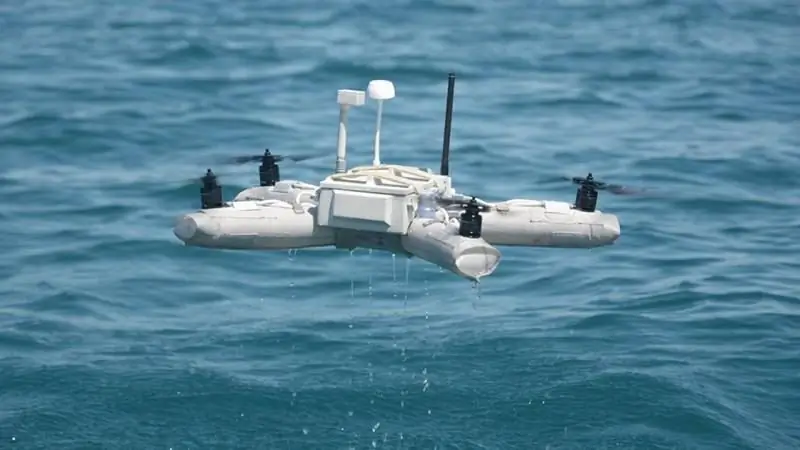
In 2017, Diodon Drone Technology introduced its SP20 quadcopter. Definitely not in the nano-UAV category due to its unusual design, it is well suited for use by special forces. This quadcopter is intended for operation in airborne units, as it has a hardened and waterproof housing in accordance with the IP46 standard with all electronics and four inflatable "legs" at the ends of which propellers with motors are installed, which allows the aircraft to stay afloat using the water surface for takeoff and landing. It can also work on land, while the inflatable elements absorb impact energy well. The Sp20 drone weighing 1.6 kg has a rated payload of 200 grams, has a maximum speed of 60 km / h and a vertical speed of 3 m / s. Two sensors are offered for it: a CCD camera with a 976x582 matrix and 3 mm, 8 mm or 12 mm lenses, capable of operating at 0,0002 lux illumination, and an uncooled thermal imager with a 14.2 mm lens and a 640x480 matrix.
The SP20 drone can fly at wind speeds of up to 25 knots, the maximum operating altitude is 2500 meters, and the operating temperatures are from -5 ° C to + 45 ° C. With deflated "paws" and folded blades, the dimensions of the apparatus are 220x280x100 mm, in working order - 550x450x190. Set-up time is less than a minute, thanks in no small part to the included small compressor used to inflate the feet. The batteries are charged for 23 minutes of flight. The SP20 is equipped with an analogue communication channel with a range of up to 2 km. Diodon's SP20 drone comes with a 1.2kg IP56 rugged ground control station. This unique amphibious UAV is currently being tested in various divisions, and Diodon Drone Technologies is awaiting the first order for it, primarily from the French military.






